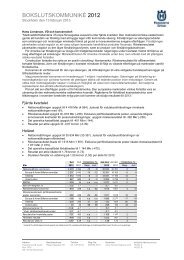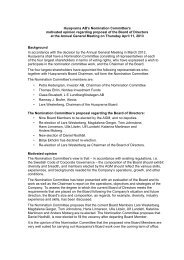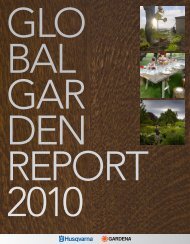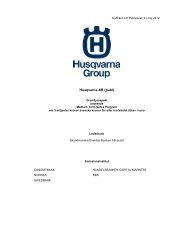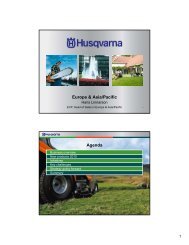Annual Report 2009 - Husqvarna Group
Annual Report 2009 - Husqvarna Group
Annual Report 2009 - Husqvarna Group
Create successful ePaper yourself
Turn your PDF publications into a flip-book with our unique Google optimized e-Paper software.
<strong>Husqvarna</strong> <strong>Annual</strong> <strong>Report</strong> <strong>2009</strong> 91<br />
Definitions<br />
Capital indicators<br />
Net assets – Total assets exclusive of liquid funds and interestbearing<br />
financial receivables less operating liabilities, noninterest-bearing<br />
provisions and deferred tax liabilities.<br />
Operating working capital – Inventories and trade receivables<br />
less trade payables.<br />
Working capital – Current assets exclusive of liquid funds and<br />
interest-bearing financial receivables less operating liabilities<br />
and non-interest-bearing provisions.<br />
Net debt – Total interest-bearing liabilities less liquid funds.<br />
Interest bearing liabilities – Long-term and short-term borrowings<br />
and fair value derivative liabilities.<br />
Liquid funds – Cash and cash equivalents, short term investments<br />
and fair value derivative assets.<br />
Net debt/equity ratio – Net debt in relation to total adjusted<br />
equity.<br />
Equity/assets ratio – Equity as a percentage of total assets.<br />
Capital employed – Total liabilities and equity less non-interest-bearing<br />
debt including deferred tax liabilities.<br />
Other key ratios<br />
Average number of shares – Weighted number of outstanding<br />
shares during the period, after repurchase of own shares.<br />
Earnings per share – Income for the period divided by the<br />
average number of shares.<br />
Net sales growth – Net sales as a percentage of the preceding<br />
period.<br />
Gross margin – Gross operating income as a percentage of<br />
net sales.<br />
Operating margin – Operating income as a percentage of<br />
net sales.<br />
Return on equity – Income for the period as a percentage of<br />
average equity.<br />
Return on capital employed – Operating income plus financial<br />
income as a percentage of average capital employed.<br />
Operating cash flow – Total cash flow from operations and<br />
investments, excluding acquisitions and divestment of operations.<br />
Capital expenditure – Property, plant and equipment and<br />
capitalization of product development and software.<br />
EBITDA – Earnings before interests, taxes, depreciation,<br />
impairment and amortization.<br />
Value creation – Operating income less the weighted average<br />
cost of capital (WACC) on average net assets: (Net sales –<br />
operating costs – operating income) – (WACC x average net<br />
assets).<br />
Excluding acquisitions – Figures excluding acquisitions are<br />
reported in order to make the current period comparable with<br />
the corresponding period in the previous year. Adjustment is<br />
made for acquisitions with annual sales of SEK 100m or more.<br />
Interest coverage ratio – Income after financial items plus<br />
financial costs divided with financial costs.<br />
Some of the historical key figures for 2005–2006 are calculated<br />
pro forma or based on combined financial statements. For more<br />
information, see the Five-year review on pages 92–93.



